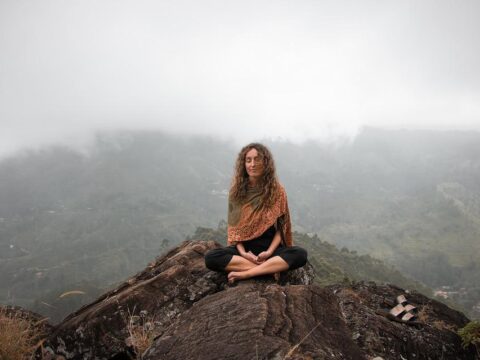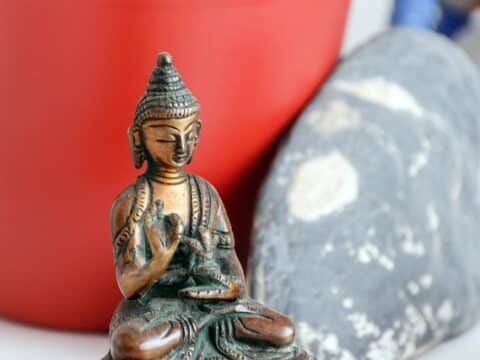Meditation is a good practice for both adults and children. Children can learn to meditate early in life. Meditation helps them to focus on things that make them happy and things that make them sad.
Meditation also helps children learn to listen to their inner voice. This helps them learn what they want and why they want it. This knowledge can help them develop healthy self-esteem and motivate themselves to achieve their goals.
Meditation even helps children control their emotions and improve their sleep quality. It is important to teach children how to meditate at an early age so they can understand the benefits.
Meditation helps children calm down during the day and before bedtime. It also helps them deal with strong emotions and time-outs. Children can practice this habit of self-care whenever they are alone. Children can learn to meditate from a trained adult or on their own.
Children are creatures of habit. If you teach them to meditate, they will naturally follow the instructions. It can also help them express their feelings better and improve their communication skills.
Podcast
Children can also learn to appreciate their surroundings. They will be more considerate of others and feel safer and calmer. They may even develop a healthier immune system and have better sleeping habits.
Meditation helps them overcome challenges and develop a positive outlook on life. Meditation also helps your child become less prone to depression and anxiety.
Stress disorders are common in today’s society. Modern children find it difficult to focus and concentrate. Children who meditate are better able to deal with these challenges. This is because their brains need time to relax.
The American Academy of Pediatrics recommends that parents and teachers incorporate meditation into their daily lives. When you teach your child how to meditate, you are giving them the greatest gift you can give them.
Stress is normal for children, but children are especially vulnerable to it. Many studies have shown that meditation can reduce stress and anxiety. Children can also benefit from learning to focus on their breath and observe nature.
There are also many easy-to-learn meditation techniques designed specifically for children. Even if you meditate for just a few minutes a day, you can get great results.
Why meditation?
Strengthening brain power
As we get older, our brains slow down. This is because our brain is always active, so there is not much room for new learning. As we get older, we need to stay mentally stimulated, and meditation is the best way to do this.
Studies have shown that adults who meditate have higher IQs. This may not sound like a big deal, but if you think about it, being smarter means you are better able to learn new things and have a better memory.
Stress level reduction
Stress is something that almost everyone is familiar with. When we feel stressed, our bodies release chemicals that make us anxious and agitated. The best thing we can do when we feel stressed is to simply breathe. In other words, try to relax. This way we can relieve the stress we feel.
Another way to relieve stress is to meditate. Meditation not only relaxes the body, but has also been shown to improve the brain. The goal is to eliminate stress completely.
Increase concentration
When we feel stressed, we get distracted very easily. If we do a short 10-minute meditation every day, we can concentrate better.
If you have children, make sure they meditate. This way they will be able to concentrate better in school and have a better memory.
Improves immune system
When we get sick all the time, it is because our immune system is not working properly. When we are stressed, our body tends to shut down. We may not be aware of it, but when we are stressed, our immune system shuts down. To have a healthy immune system, we need to keep our bodies in balance.
One of the best ways to do this is to meditate. Studies have shown that meditation improves our immune system, and this can only help us.
Can lower blood pressure
If you are feeling stressed, there is a good chance that your blood pressure is high. When you are stressed, our heart rate increases, which increases our blood pressure. This may be uncomfortable at times, but if you want to have a long and healthy life, you need to keep your blood pressure under control.
Thought Hunter Meditation
It is called “Thought Hunter Meditation”. This meditation is designed to help you banish negative thoughts and emotions from your mind. This meditation is a simple process that will lead to greater clarity, peace and mental freedom.
Let us do the meditation now.
First, close your eyes and relax. Let your body and mind become as comfortable as possible.
At first you may feel a little uncomfortable doing this meditation, but soon your mind will become calm and serene.
You will begin to notice things that may have bothered you before. When this happens, just watch these thoughts pass by. Don’t try to figure out what is going on in your mind, just watch them pass.
In time the thoughts will stop and you will be left with pure clarity.
That’s it, the meditation is over. Now open your eyes.
Take a few moments to reflect on your experience. Did you notice anything unusual?
Do you notice anything else that was troubling you before? If so, why were you worried about it?
As you continue to practise these techniques, you will notice that your thoughts begin to change and become more positive.
You will find that you think about the things you enjoy most. You may even begin to think of things you would like to change in your life.
Now you can start using the methods of meditation to make positive changes in your life.
Meditation by counting
There is a simple and effective way to get in touch with your inner peace and serenity.
This meditation is about counting to 10 and focusing on one thing at a time.
One of the best ways to practice concentration is through counting meditations. The idea behind counting meditations is simple. You count your breaths for a certain amount of time. Then you move on to the next number. And when you reach zero, you stop and let your mind wander.
To begin, sit in a comfortable position.
Close your eyes, breathe deeply and relax your body.
Then start counting slowly from 1 to 10 as you inhale.
1.2.3.4.5.6.7.8.9.10.
After counting to 10, exhale and repeat the process.
When you have finished, you should be able to feel the calmness of the breath and your concentration on the present moment.
Counting thoughts
Meditation is a great way to relax and take control of your mind. It is also a great way to focus better, increase your creativity and develop self-discipline.
To meditate, all you need to do is close your eyes and focus on your breathing. You can meditate either sitting or lying down. Try to clear your mind of all thoughts and distractions and focus only on your breath.
Counting your breaths is a good way to start your meditation. Simply start by counting your breaths, in through your nose and out through your mouth. Then count your breaths in a steady and rhythmic rhythm.
Once you have learned the basics, you can start counting your breaths in different patterns. For example, if you count slowly and evenly while counting your breaths, you can easily focus on the present moment.
Another pattern that is often used in meditation is the following. First you breathe in, and when you breathe out, you say “one” softly. When you breathe in again, silently count “two”. Say “one” and “two” after each breath. This creates a counting pattern that helps you to focus on the present moment.
Closing the senses
The meditation “Closing the senses” is a very popular form of meditation and is often taught in connection with yoga. This involves closing your eyes, breathing deeply and concentrating on only hearing sounds.
This is one of the most important meditation exercises for beginners because it helps you to disconnect your mind from the outside world. Instead of focusing on the sounds of traffic or the television, you can focus on the sounds of nature.
You can practise this meditation at any time, but it is especially helpful when you need to calm yourself down.
Here is a quick meditation for closing the senses. It will help you close the senses for meditation practice. It can be used before or after any meditation practice.
To do this meditation, sit comfortably cross-legged or on a chair. Relax your jaw and neck muscles, take a deep breath and relax your eyes. Now close your ears to your surroundings and concentrate on your breathing.
Next, slowly and gently close your eyes and let your eyes flutter. Feel your eyes become heavy and droopy. Slowly feel your eyelids begin to close. Let the darkness move over your gaze.
Now imagine that a light is falling into your eyes. Feel it fill your eyes and burn away the darkness. Then imagine it slowly moving from the inside out. Imagine your pupils dilating to let more light into your eyes. The light becomes brighter and stronger until it fills your whole body.
After this visualisation, open your eyes and take a few deep breaths.
Meditation for mindful listening
What is Mindful Listening Meditation? Mindful listening meditation is when you intentionally practice listening to music or nature sounds in a mindful and unbiased way.
It helps you to get more out of life. It makes it easier for you to hear what is really important to you. It helps you to be more in touch with your surroundings. It makes it easier to understand others better.
Mindful listening meditation is something that will change your life.
Close your eyes and let go of all thoughts and distractions.
Just concentrate on the sound. Let go of your thoughts and feelings and just notice the sounds around you.
Listen to the birds chirping, the traffic, the wind, the waves crashing against the shore. Whatever is happening around you at the moment.
Let yourself be completely absorbed by the sounds around you.
Sitting still together
In our meditation of sitting still together we will explore the practice of stillness and what it can teach us. We will focus on finding stillness in the busyness of our lives and allowing ourselves to come to rest.
Our minds are always in motion and there is no need to add anything else. This is a time to just breathe and feel the peace and calm that we naturally have within us. This is a benefit for children, adults and those who struggle with ADHD.
It is important to remember that our bodies are able to do things for us that our minds cannot. Our minds think all the time, but our bodies rarely think.
Our bodies are constantly working to keep us alive, so why not use them to heal us? This meditation teaches us to become aware of our body and use it to help us when we need it.
It is best to sit comfortably in a place where you will not be disturbed and in a quiet environment. Close your eyes and take three deep breaths. Now breathe in and out slowly through your mouth.
Once you are ready, notice how your body feels. How does your body feel? Does your chest feel heavy? Are your legs trembling? Do you have butterflies in your stomach? Does your heart, palpitations? Are you sweating? Do you feel like you have a headache? Is your jaw tense?
The first step in this meditation is simple: notice your body. As soon as you do this, you are on the right path.
Now let your mind calm down and notice what your body is doing. Is your jaw tightening? Do you have butterflies in your stomach? Is your heart beating faster? Are your hands getting cold? Is your body trembling? Are you hot or cold? Do you hear a ticking sound in your ears?
If you become more aware of your body, you will find that you experience things you didn’t know you could feel. Pay attention to what your body is doing, even if it seems strange or unusual.
When you have noticed everything your body is doing, you are ready to start the next part of the meditation.
Now is a good time to open your eyes and open your mind. When we are calm and relaxed, we can sense what is going on around us. We are able to see the world in a new way. Our senses become sharper.
This is how the Buddha described the way our senses work. He said that our senses are the windows of our souls. He also said that through our senses we know what is happening in our lives.
The Buddha described it this way, that our senses are like a computer. They enable us to see, hear, taste, smell, touch and think. But they are not our whole self.
Our whole self is the thoughts that come from our heart. So the way we use our senses is to open our hearts and allow ourselves to see the world through them.



